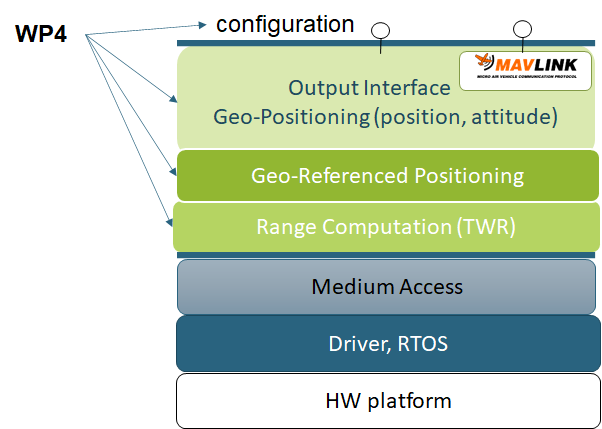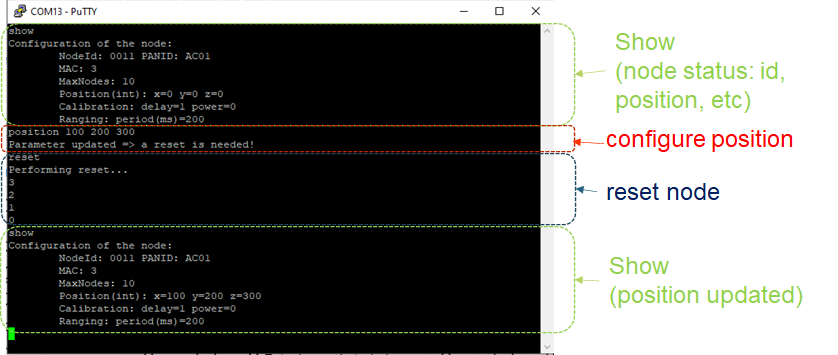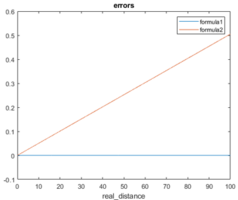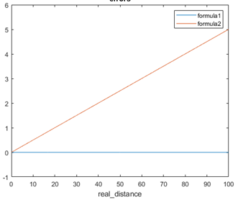WP4-17: Difference between revisions
| Line 85: | Line 85: | ||
</gallery> | </gallery> | ||
The a) scenario represents an ideal case and serves to show the analytical equivalence of the considered formulations. | |||
The b) scenario shows that for an averave drift on a platform with crystal clocks, a minor reply time unbalance, will already mean a significant range error (0.5m at 10mm distance) for 'formula2'. | |||
The c) scenario shows that considering a further, but quite feasible unbalance (100us), the error at 100m becomes 5m, yet 0.5m for 10m for 'formula2'. | |||
Then, c) scenario shows that even under consideration of some already provided platform inprovements (TCXO clock), the aforementioned error magnitude for 'formula2' holds, while 'formula1' remains insensitive. | |||
Therefore, the selection of the proper formulation ('formula1') is critical for error free range estimations. | |||
(TBC: comments on positioning algorithms) | (TBC: comments on positioning algorithms) | ||
Revision as of 11:44, 14 March 2023
Anchor&Tag firmware of the Indoor Positioning System
| ID | WP4-17 |
| Contributor | ACORDE |
| Levels | Function |
| Require | Indoor Positioning System anchor and tag platforms WP3-15_1 |
| Provide | Navigation data (position) |
| Input | Raw sensed data from UWB transceiver. RTK enabled positioning out of the tunnel. INS data (on the tag). |
| Output | Position |
| C4D building block | |
| TRL | 4 |
| Parent Building block | WP3-15_1 |
| Contact | fernando.herrera at acorde.com |
This page introduced the software developed for Indoor Positioning solution developed by ACORDE in COMP4DRONES. It includes tag and anchor firmware (application and other underlying levels).
Description
The following figure shows the several software layers present on top of the HW anchor&tag devices of the ACORDE Indoor Positioning Solution (IPS) addressed.
The development of the ACORDE IPS has required actions and developments on all these layers. Some of these layers have been tackled on other project WPs:
- BSP set up (in WP3)-15-1, which includes drivers and RTOS adaptation/configuration
- Medium Access Control protocol (in WP5-19_ACO), where acorde has made specific innovation.
The higher software levels of the soltions have been addressed in the context of the WP4 of COMP4RDRONES, as described in the figure.
The layers addressed are:
- Upper application layers, in charge of I/O interfacing (e.g. support of Mavlink API) and configuration.
- geo-positioning, which includes geo-positioning via trilateration and fusion techniques in general
- ranging, in charge of computation of ranges derived from the time metrics derived from UWB message exchages
Contributions
The efforts invested in WP4 for the uppers layers of the ACORDE IPS solution have been fruitful in the afore introduced layers.
They can be sum up as follows:
- A first version of CCM in place
- Selection and implementation of development of a TWR ranging scheme
- Development of two versions of positioning algorithms
- Service for local and remote control, configuration and monitoring (CCM)
Validation
At the user application level the following figure provides an example where ACORDE validated the possibility to remotely configure, control and monitor the node.
In first place, a show command is issued to read the node status (monitoring). Then the position of the UWB anchor is manually configured, and then the node is reseted to ensure new configuration is applied (monitoring and control). Finally, a new show command is issued to check the effectivity of the CCM sequence.
At the "ranging layer", as mentioned, ACORDE realised the importance on not only implementing, byt selecting and appropriate Two-Way Ranging (TWR) scheme. The following figure shows how two different TWR formulations were evaluated for four scenarios accounting tow typical error sources:
- The error frequency of both the initiator and responder clocks (Δfi, Δfr, in parts per million, PPM)
- The unbalancing on the reply times (Δt_reply).
From these two error sources, four scenarios are defined:
a) an ideal case: Δfi=0, Δfr=0, Δt_{reply}=0
b) average crystal frequency drifts crystal and minor reply time unbalance: Δfi=50PPM, Δfr=-50PPM, Δtreply=10µs
c) average crystal frequency drifts crystal and feasible unbalance : Δfi=50PPM, Δfr=-50PPM, Δtreply=100µs
d) average TCXO frequency drifts crystal and feasible unbalance : Δfi=4PPM, Δfr=-4PPM, Δtreply=100µs
The a) scenario represents an ideal case and serves to show the analytical equivalence of the considered formulations. The b) scenario shows that for an averave drift on a platform with crystal clocks, a minor reply time unbalance, will already mean a significant range error (0.5m at 10mm distance) for 'formula2'. The c) scenario shows that considering a further, but quite feasible unbalance (100us), the error at 100m becomes 5m, yet 0.5m for 10m for 'formula2'. Then, c) scenario shows that even under consideration of some already provided platform inprovements (TCXO clock), the aforementioned error magnitude for 'formula2' holds, while 'formula1' remains insensitive. Therefore, the selection of the proper formulation ('formula1') is critical for error free range estimations.
(TBC: comments on positioning algorithms)





